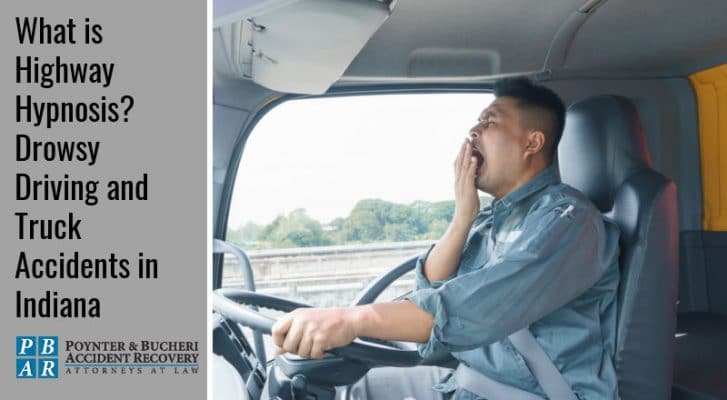
What is Highway Hypnosis? Drowsy Driving and Truck Accidents in Indiana

What you’ll learn reading this article:
- What is highway hypnosis?
- How can highway hypnosis and drowsy driving accidents be avoided?
Have you ever found yourself in your driveway after commuting home from work and realized that you have no recollection of the actual journey? Your brain was on a kind of automatic pilot.
This situation is quite common–common enough to have a name: Highway Hypnosis. Because drivers are often lulled into a semi-hypnotic state by the unbroken stretches of white lines on a highway, it is also referred to as White Line Fever.
Why do drivers experience a kind of trance-like hypnosis when they drive for long stretches on the highway? There are two main reasons: monotony and fatigue.
Monotony:
A 2003 study used a driving simulator to compare two sets of drivers. The first set experienced long stretches of tedious landscape with no distinguishing features other than pine trees spaced evenly along the road.
The second set saw a variety of visual stimuli, such as trees, farms, signs, people, overpasses, and bridges. The set of drivers on the monotonous road exhibited slower reaction times and larger steering movements. Fatigue kicked in after twenty minutes or so.
Fatigue:
Not only can fatigue cause highway hypnosis, but it can also be caused by highway hypnosis. Either combination can be extremely dangerous. According to the National Highway Traffic Safety Administration, at least 100,000 police-reported crashes are the direct result of driver fatigue each year, resulting in an estimated 1,550 deaths and 71,000 injuries.
A study by the AAA reported an even more horrifying annual number of drowsy driving accidents: 328,000!
(The discrepancy is explained by the fact that unlike with alcohol or drug-related crashes, it is difficult to conclusively test for drowsy driving.)
There are over 15.5 million semi-trucks on the road; when fully loaded, they can weigh over 80,000 pounds. In fact, the upcoming Indiana House Bill 1190 is looking to increase the weight limit for trucks on Indiana roads from 80,000 pounds to 120,000 pounds. Imagine 80,000 – 120,000 pounds of metal and cargo heading into your lane as a truck driver’s eyes glass over with fatigue or monotony.
It is terrible to consider and even worse to live through, but sadly, truck drivers with highway hypnosis or fatigue are a real danger. A study conducted by the FMCSA (Federal Motor Carrier Safety Administration) found that 13% of truck accidents were caused by driver fatigue.
The federal government requires that commercial truck drivers abide by the Hours of Service Regulations, so they are limited to 11 hours of driving each day with a thirty-minute break built-in. Unfortunately, in order to meet sometimes unrealistic deadlines, some truck drivers fudge their logbooks and drive more than they should.
However, even scrupulously honest drivers can be affected by fatigue because their sleep patterns are inconsistent. An NIH (National Institutes of Health) study showed that long-distance truck drivers do not get enough sleep for optimal alertness.
What truck drivers can do to lessen the chance of an accident:
If you are a commercial truck driver — or even if you are just a run of the mill vehicle driver who wants to stay alert enough to avoid highway hypnosis, there are a few measures you can take to minimize your risk:
- Get enough sleep: The Hours of Service regulations require a 10-hour off-duty time before a maximum of 11 hours of driving or an 8-hour off-duty time before a maximum of 10 hours of driving. Use those off-duty times to sleep. This is easier said than done, but relaxation techniques and calming podcasts can help.
- If you have problems sleeping, consult a doctor. You may have a sleep disorder like sleep apnea that can make you drowsy in the daytime.
- Keep the temperature cool as you drive. Being comfortable can lead to too much relaxation. Your body may also use up its energy trying to keep you from sweating.
- Drink enough water to stay hydrated.
- Avoid medications (even over the counter medications) that could cause drowsiness
- Play music that is lively and that can give you a shot of energy.
- Stay away from boring or monotonous podcasts or audiobooks.
- Take frequent breaks.
- Try to consciously notice the scenery and what is happening around you instead of drifting into introspection and white line fever.
- Avoid heavy or carb-filled meals before driving. Spaced-out healthy snacks are better for your body and for your alertness levels.
- Open the windows and get some fresh air.
- If you do realize that you have ‘spaced out” for a period of time, get off at the closest exit and have a quick 20-minute nap to refresh yourself. Walk around in the fresh air before you get back on the road.
In Indiana, 3,297 persons were injured in commercial vehicle collisions in 2017, resulting in 152 fatalities. Fully 90 of these collisions were due primarily to driver fatigue or highway hypnosis. If you find yourself involved in an accident with a truck in Indiana, you will need to contact an Indianapolis truck accident attorney immediately.
Trucking companies and their insurance providers have teams of professionals working to protect their best interests; therefore, you need the Poynter & Bucheri personal injury lawyers on your side to balance the playing field.
Our personal injury attorneys are experienced with cases like yours and can evaluate what your case may be worth. Plus, we charge no attorney fees, unless you win. Call today for a free case review at 1-800-265-9881, or contact us online.
